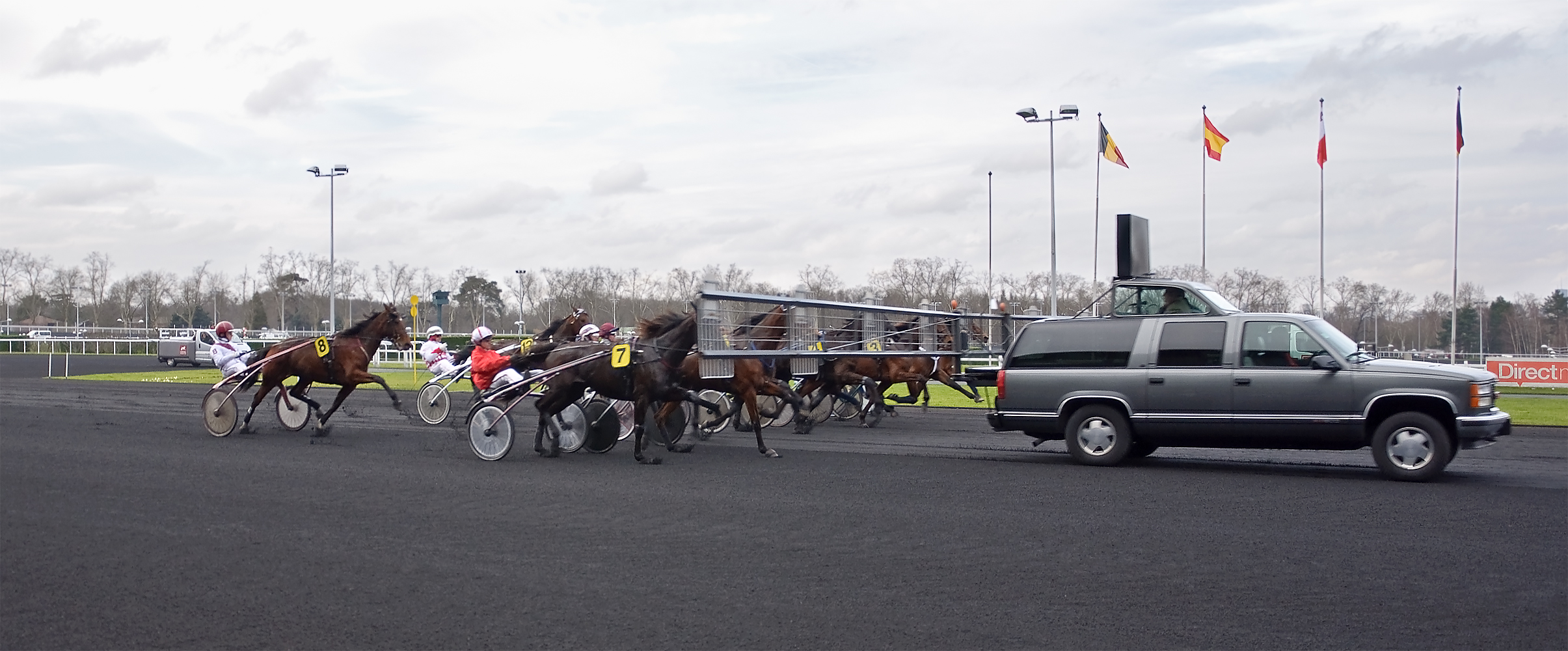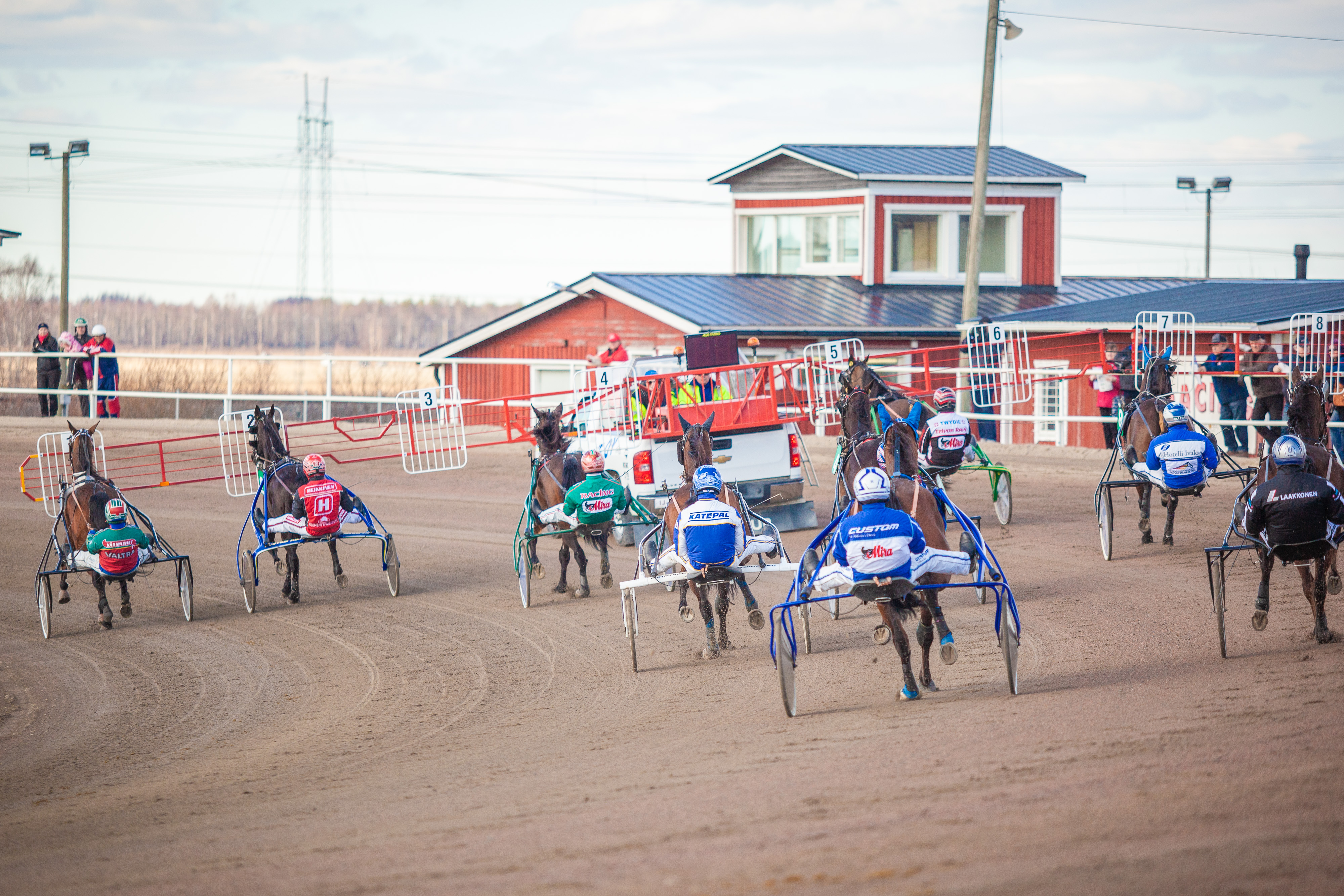|
Keith Waples
Keith Gordon Waples (December 8, 1923 – May 7, 2021) was a Canadian Hall of Fame sulky driver and horse trainer in the sport of harness racing. In 1959, Waples became the first driver to record a sub two-minute mile in Canada and the first to win a $100,000 race in Canada. In 1962, Keith Waples drove Tie Silk to victory in the International Trot at Roosevelt Raceway and in 1972 with the colt Strike Out he won the Little Brown Jug, the Adios Pace and Prix d'Été. Keith Waples was inducted into Canada's Sports Hall of Fame in 1973 and the Canadian Horse Racing Hall of Fame The Canadian Horse Racing Hall of Fame was established in 1976 to honour those who have made a significant contribution to the sport of harness and Thoroughbred horse racing in Canada. It is located at Woodbine Racetrack in Toronto, Ontario. The ... in 1978 and the United States Harness Racing Hall of Fame in 1987. In 2008, Waples was an inductee (Athlete category) of the Midland (Ontario) Sports ... [...More Info...] [...Related Items...] OR: [Wikipedia] [Google] [Baidu] |
Harness Racing
Harness racing is a form of horse racing in which the horses race at a specific gait (a trot or a pace). They usually pull a two-wheeled cart called a sulky, or spider, or chariot occupied by a driver. In Europe, and less frequently in Australia and New Zealand, races with jockeys riding directly on saddled trotters ( in French) are also conducted. Breeds In North America, harness races are restricted to Standardbred horses, although European racehorses may also be French Trotters or Russian Trotters, or have mixed ancestry with lineages from multiple breeds. Orlov Trotters race separately in Russia. The light cold-blooded Coldblood trotters and Finnhorses race separately in Finland, Norway and Sweden. Standardbreds are so named because in the early years of the Standardbred stud book, only horses who could trot or pace a mile in a ''standard'' time (or whose progeny could do so) of no more than 2 minutes, 30 seconds were admitted to the book. The horses have prop ... [...More Info...] [...Related Items...] OR: [Wikipedia] [Google] [Baidu] |
Harness Racing Museum & Hall Of Fame
The Harness Racing Museum & Hall of Fame is a museum in Goshen, New York. The museum collects and preserves the history of harness racing and serves as a hall of fame for the American Standardbred horse. Orange County is the birthplace of Hambletonian 10, the ancestor of all American Standardbred horses, and many of the early Hambletonian races were held in Goshen at the Good Time Park mile track. Established in 1838, the neighboring half-mile Historic Track is a National Historic Landmark, the oldest harness horse track still in use in the United States. Stables still operate on the grounds, and races are held annually. The museum opened in 1951, during Goshen's Hambletonian Stake era. Hall of Fame The half-timber building that houses the museum was built as a stable in 1913. It houses artwork by famous equine artists and racing memorabilia dating back to the start of trotting. Exhibits include more than 1,700 paintings, lithographs and sculptures, 19,300 photographs, h ... [...More Info...] [...Related Items...] OR: [Wikipedia] [Google] [Baidu] |
Canadian Horse Racing Hall Of Fame Inductees
Canadians (french: Canadiens) are people identified with the country of Canada. This connection may be residential, legal, historical or cultural. For most Canadians, many (or all) of these connections exist and are collectively the source of their being ''Canadian''. Canada is a multilingual and multicultural society home to people of groups of many different ethnic, religious, and national origins, with the majority of the population made up of Old World immigrants and their descendants. Following the initial period of French and then the much larger British colonization, different waves (or peaks) of immigration and settlement of non-indigenous peoples took place over the course of nearly two centuries and continue today. Elements of Indigenous, French, British, and more recent immigrant customs, languages, and religions have combined to form the culture of Canada, and thus a Canadian identity. Canada has also been strongly influenced by its linguistic, geographic, and eco ... [...More Info...] [...Related Items...] OR: [Wikipedia] [Google] [Baidu] |
2021 Deaths
This is a list of deaths of notable people, organised by year. New deaths articles are added to their respective month (e.g., Deaths in ) and then linked here. 2022 2021 2020 2019 2018 2017 2016 2015 2014 2013 2012 2011 2010 2009 2008 2007 2006 2005 2004 2003 2002 2001 2000 1999 1998 1997 1996 1995 1994 1993 1992 1991 1990 1989 1988 1987 See also * Lists of deaths by day * :Deaths by year, Deaths by year {{DEFAULTSORT:deaths by year Lists of deaths by year, ... [...More Info...] [...Related Items...] OR: [Wikipedia] [Google] [Baidu] |
1923 Births
Nineteen or 19 may refer to: * 19 (number), the natural number following 18 and preceding 20 * one of the years 19 BC, AD 19, 1919, 2019 Films * ''19'' (film), a 2001 Japanese film * ''Nineteen'' (film), a 1987 science fiction film Music * 19 (band), a Japanese pop music duo Albums * ''19'' (Adele album), 2008 * ''19'', a 2003 album by Alsou * ''19'', a 2006 album by Evan Yo * ''19'', a 2018 album by MHD * ''19'', one half of the double album '' 63/19'' by Kool A.D. * '' Number Nineteen'', a 1971 album by American jazz pianist Mal Waldron * ''XIX'' (EP), a 2019 EP by 1the9 Songs * "19" (song), a 1985 song by British musician Paul Hardcastle. * "Nineteen", a song by Bad4Good from the 1992 album ''Refugee'' * "Nineteen", a song by Karma to Burn from the 2001 album ''Almost Heathen''. * "Nineteen" (song), a 2007 song by American singer Billy Ray Cyrus. * "Nineteen", a song by Tegan and Sara from the 2007 album '' The Con''. * "XIX" (song), a 2014 song by Slip ... [...More Info...] [...Related Items...] OR: [Wikipedia] [Google] [Baidu] |
Roosevelt Raceway (harness Racing)
Roosevelt Raceway was a race track located just outside the village of Westbury on Long Island, New York. Initially created as a venue for motor racing, it was converted to a ½-mile harness racing facility (the actual circumference was 100 feet shorter). The harness racing facility operated from September 2, 1940 until July 15, 1988. It was the original home of the Messenger Stakes, part of the Triple Crown of Harness Racing for Pacers. The raceway hosted the event until it closed. It was also the first track to use the now universal "mobile starting gate". The operation was sold in 1984 on the condition it was to remain an operating racetrack, but the facilities deteriorated, attendance dropped off, and the plant was no longer profitable. The site of Roosevelt Raceway is part of the Hempstead Plains, located in an unincorporated area of the Town of Hempstead, within the Westbury 11590 Zip Code. It is located near where the first English Governor of New York, Richard Nicolls, ... [...More Info...] [...Related Items...] OR: [Wikipedia] [Google] [Baidu] |
Harness Racing
Harness racing is a form of horse racing in which the horses race at a specific gait (a trot or a pace). They usually pull a two-wheeled cart called a sulky, or spider, or chariot occupied by a driver. In Europe, and less frequently in Australia and New Zealand, races with jockeys riding directly on saddled trotters ( in French) are also conducted. Breeds In North America, harness races are restricted to Standardbred horses, although European racehorses may also be French Trotters or Russian Trotters, or have mixed ancestry with lineages from multiple breeds. Orlov Trotters race separately in Russia. The light cold-blooded Coldblood trotters and Finnhorses race separately in Finland, Norway and Sweden. Standardbreds are so named because in the early years of the Standardbred stud book, only horses who could trot or pace a mile in a ''standard'' time (or whose progeny could do so) of no more than 2 minutes, 30 seconds were admitted to the book. The horses have prop ... [...More Info...] [...Related Items...] OR: [Wikipedia] [Google] [Baidu] |
Sulky
A sulky is a lightweight cart with two wheels and a seat for the driver, generally pulled by horses or dogs. With horses, a sulky is used for harness racing. The term is also used for an arch-mounted cart on wheels or crawler tracks, used in logging, or other types of vehicle having wheels and usually a seat for the driver, such as a plough, lister or cultivator. Horse sulky A sulky for horses is a lightweight two-wheeled, single-seat cart that is used as a form of rural transport in many parts of the world. A special development of this is now used in most forms of harness racing in Argentina, Australia, Canada, France, the United States and New Zealand, including both trotting and pacing races. They are reputedly called "sulkies" because the driver must prefer to be alone."The Encyclopaedia of Driving" 1979, by Sallie Walrond Race sulkies come in two categories, * Traditional symmetrical sulkies * Asymmetric or "offset" sulkies An "improved sulky" with pneumatic ti ... [...More Info...] [...Related Items...] OR: [Wikipedia] [Google] [Baidu] |
Strike Out
In baseball or softball, a strikeout (or strike-out) occurs when a batter accumulates three strikes during a time at bat. It usually means that the batter is out. A strikeout is a statistic recorded for both pitchers and batters, and is denoted by K in scorekeeping and statistics. A "strikeout looking" — in which the batter does not swing and the third strike is called by the umpire — is usually denoted by a ꓘ. Although a strikeout suggests that the pitcher dominated the batter, the free-swinging style that generates home runs also leaves batters susceptible to striking out. Some of the greatest home run hitters of all time—such as Alex Rodriguez, Reggie Jackson, and Jim Thome—were notorious for striking out. Rules and jargon A pitched ball is ruled a ''ball'' by the umpire if the batter did not swing at it and, in that umpire's judgement, it does not pass through the strike zone. Any pitch at which the batter swings unsuccessfully or, that in that umpire's judge ... [...More Info...] [...Related Items...] OR: [Wikipedia] [Google] [Baidu] |
Tie Silk
Tie has two principal meanings: * Tie (draw), a finish to a competition with identical results, particularly sports * Necktie, a long piece of cloth worn around the neck or shoulders Tie or TIE may also refer to: Engineering and technology * Tie (engineering), a strong component designed to keep two objects closely linked together * Railroad tie, a rectangular support for the rail * Tensilica Instruction Extension, a verilog-like language that is used to describe the instruction extensions to the Xtensa processor core * Time Independent Escape Sequence, a modem protocol Enterprises and organizations * TiE (The Indus Entrepreneurs), a Silicon Valley non-profit * Titanium Metals Corporation, with the stock symbol TIE on the New York Stock Exchange * Transport Initiatives Edinburgh Ltd., an Edinburgh-based public transport company Science * Interpersonal ties, in sociology and psychology * TIE receptors, specific types of cell surface receptors Acronym * Theatre in Educatio ... [...More Info...] [...Related Items...] OR: [Wikipedia] [Google] [Baidu] |


.jpg)
